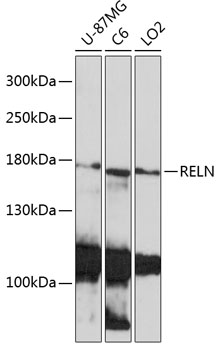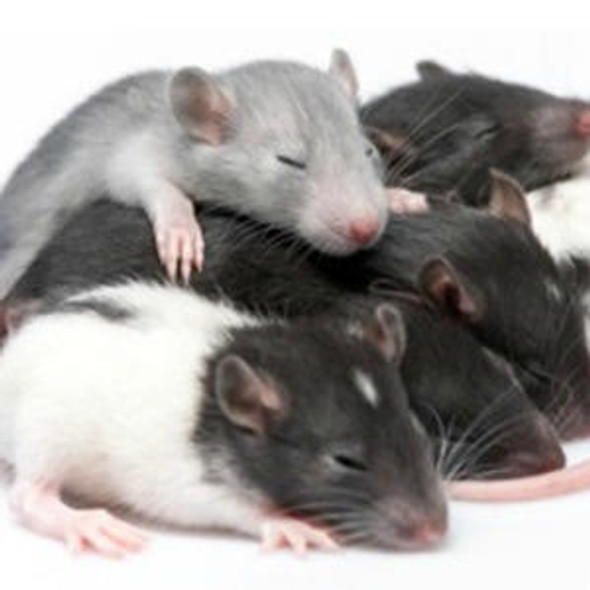Cell Biology Antibodies 14
Anti-RELN Antibody (CAB17936)
- SKU:
- CAB17936
- Product Type:
- Antibody
- Reactivity:
- Human
- Reactivity:
- Mouse
- Reactivity:
- Rat
- Host Species:
- Rabbit
- Isotype:
- IgG
- Antibody Type:
- Polyclonal Antibody
- Research Area:
- Cell Biology
Description
| Antibody Name: | Anti-RELN Antibody |
| Antibody SKU: | CAB17936 |
| Antibody Size: | 20uL, 50uL, 100uL |
| Application: | WB IHC |
| Reactivity: | Human, Mouse, Rat |
| Host Species: | Rabbit |
| Immunogen: | Recombinant protein of human RELN. |
| Application: | WB IHC |
| Recommended Dilution: | WB 1:500 - 1:2000 IHC 1:50 - 1:200 |
| Reactivity: | Human, Mouse, Rat |
| Positive Samples: | U-87MG, C6, LO2, HepG2 |
| Immunogen: | Recombinant protein of human RELN. |
| Purification Method: | Affinity purification |
| Storage Buffer: | Store at -20°C. Avoid freeze / thaw cycles. Buffer: PBS with 0.02% sodium azide, 50% glycerol, pH7.3. |
| Isotype: | IgG |
| Sequence: | Email for sequence |
| Gene ID: | 5649 |
| Uniprot: | P78509 |
| Cellular Location: | |
| Calculated MW: | |
| Observed MW: | 180KDa/388KDa |
| Synonyms: | ETL7, LIS2, PRO1598, RL, RELN |
| Background: | This gene encodes a large secreted extracellular matrix protein thought to control cell-cell interactions critical for cell positioning and neuronal migration during brain development. This protein may be involved in schizophrenia, autism, bipolar disorder, major depression and in migration defects associated with temporal lobe epilepsy. Mutations of this gene are associated with autosomal recessive lissencephaly with cerebellar hypoplasia. Two transcript variants encoding distinct isoforms have been identified for this gene. Other transcript variants have been described but their full length nature has not been determined. [provided by RefSeq, Jul 2008] |
| UniProt Protein Function: | reelin: Extracellular matrix serine protease that plays a role in layering of neurons in the cerebral cortex and cerebellum. Regulates microtubule function in neurons and neuronal migration. Affects migration of sympathetic preganglionic neurons in the spinal cord, where it seems to act as a barrier to neuronal migration. Enzymatic activity is important for the modulation of cell adhesion. Binding to the extracellular domains of lipoprotein receptors VLDLR and LRP8/APOER2 induces tyrosine phosphorylation of DAB1 and modulation of TAU phosphorylation. Defects in RELN are the cause of lissencephaly type 2 (LIS2); also known as lissencephaly with cerebellar hypoplasia or Norman-Roberts syndrome. LIS2 is a classic type lissencephaly associated with abnormalities of the cerebellum, hippocampus and brainstem. Individuals with LIS2 are severely ataxic, mentally retarded and suffer from epilepsy. Belongs to the reelin family. 3 isoforms of the human protein are produced by alternative splicing. |
| UniProt Protein Details: | Protein type:Cell development/differentiation; Secreted; Cell adhesion; EC 3.4.21.-; Protease; Secreted, signal peptide; Motility/polarity/chemotaxis Chromosomal Location of Human Ortholog: 7q22 Cellular Component: extracellular space; proteinaceous extracellular matrix; cytoplasm; dendrite Molecular Function:serine-type peptidase activity; metal ion binding; protein serine/threonine/tyrosine kinase activity Biological Process: cellular morphogenesis during differentiation; axon guidance; central nervous system development; peptidyl-tyrosine phosphorylation; spinal cord patterning; neuron migration; response to pain; proteolysis; positive regulation of synaptic transmission, glutamatergic; glial cell differentiation; dendrite development; cell adhesion; layer formation in the cerebral cortex; positive regulation of TOR signaling pathway; associative learning; regulation of behavior; regulation of synaptic transmission; cerebral cortex tangential migration; hippocampus development; activation of CREB transcription factor; ventral spinal cord development; positive regulation of phosphoinositide 3-kinase cascade; positive regulation of small GTPase mediated signal transduction; positive regulation of peptidyl-tyrosine phosphorylation; long-term memory; positive regulation of protein kinase activity; brain development Disease: Epilepsy, Familial Temporal Lobe, 7; Lissencephaly 2; Epilepsy, Familial Temporal Lobe, 1 |
| NCBI Summary: | This gene encodes a large secreted extracellular matrix protein thought to control cell-cell interactions critical for cell positioning and neuronal migration during brain development. This protein may be involved in schizophrenia, autism, bipolar disorder, major depression and in migration defects associated with temporal lobe epilepsy. Mutations of this gene are associated with autosomal recessive lissencephaly with cerebellar hypoplasia. Two transcript variants encoding distinct isoforms have been identified for this gene. Other transcript variants have been described but their full length nature has not been determined. [provided by RefSeq, Jul 2008] |
| UniProt Code: | P78509 |
| NCBI GenInfo Identifier: | 1743885 |
| NCBI Gene ID: | 5649 |
| NCBI Accession: | AAC51105.1 |
| UniProt Secondary Accession: | P78509,Q86UJ0, Q86UJ8, Q8NDV0, Q9UDQ2, A4D0P9, A4D0Q0 |
| UniProt Related Accession: | P78509 |
| Molecular Weight: | 384,093 Da |
| NCBI Full Name: | reelin |
| NCBI Synonym Full Names: | reelin |
| NCBI Official Symbol: | RELN |
| NCBI Official Synonym Symbols: | RL; ETL7; LIS2; PRO1598 |
| NCBI Protein Information: | reelin |
| UniProt Protein Name: | Reelin |
| UniProt Gene Name: | RELN |
| UniProt Entry Name: | RELN_HUMAN |







